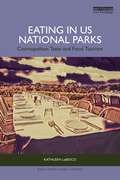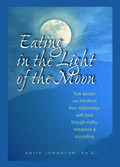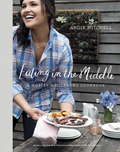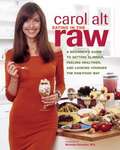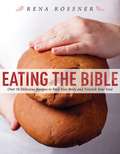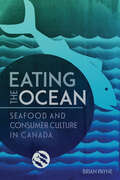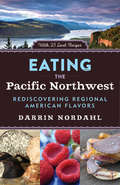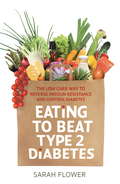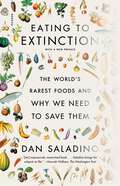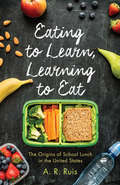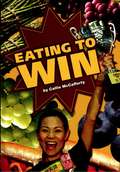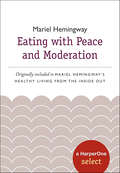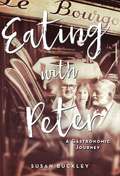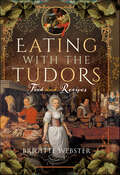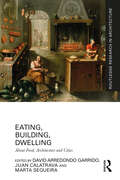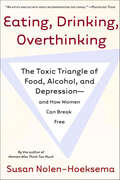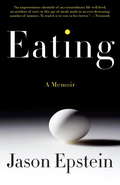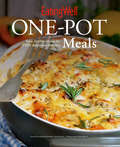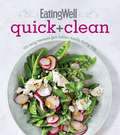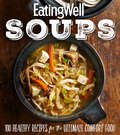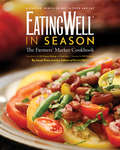- Table View
- List View
Eating in US National Parks: Cosmopolitan Taste and Food Tourism (Routledge Food Studies)
by Kathleen LeBescoThis book presents a fascinating exploration of eating experiences within US national parks, explaining how, on what, and why people eat in national parks and how this has changed over the last century. National parks are enjoying unprecedented popularity, and they are especially popular sites for the expression of cosmopolitanism, an ideological outlook descended from the Romantics on whose vision the parks were originally founded. The book explores the constructed foodscape within US national parks, situating the romantic consumption ethos within the context of sociological work on distinction, culinary tourism, and culinary capital. It analyzes and problematizes elements of cosmopolitan taste and desire, examining food tourism in wilderness spaces that satisfies cosmopolitan hunger for authenticity and a certain type of self-making. Weaving together strands of research that have not been previously integrated, the book gleans meaning from concessions menus and park restaurant web pages and employs audience analysis to take stock of park restaurant visitors’ contributions to restaurant review websites, as well as to understand how they represent their park eating experiences on social media. The book examines how satisfying cosmopolitan tastes in the parks creates profit for corporate concessioners, but also may produce bioregionalist successes and a recentering of Indigenous foodways. It concludes by exploring inroads to a better food experience in the parks, involving food products and processes that are regionally/locally specific, where tourists witness and participate in food production and enjoy commensality, but that are also non-extractive and show care for the environment and the people who inhabit it. This book will be of great interest to students and scholars of food studies, tourism and hospitality, sociology of culture, parks and recreation, American studies, and environmental studies. The book will also be of interest to parks and recreation decision makers, sustainable tourism leaders, and hospitality managers.
Eating in the Light of the Moon
by Anita JohnstonBy weaving practical insights and exercises through a rich tapestry of multicultural myths, ancient legends, and folktales, Anita Johnston helps the millions of women preoccupied with their weight discover and address the issues behind their negative attitudes toward food.
Eating in the Middle: A Mostly Wholesome Cookbook
by Andie MitchellIn her inspiring New York Times bestselling memoir, It Was Me All Along, Andie Mitchell chronicled her struggles with obesity, losing weight, and finding balance. <P><P>Now, in her debut cookbook, she gives readers the dishes that helped her reach her goals and maintain her new size. In 80 recipes, she shows how she eats: mostly healthy meals that are packed with flavor, like Lemon Roasted Chicken with Moroccan Couscous and Butternut Squash Salad with Kale and Pomegranate, and then the “sometimes” foods, the indulgences such as Peanut Butter Mousse Pie with Marshmallow Whipped Cream, because life just needs dessert. With 75 photographs and Andie’s beautiful storytelling, Eating in the Middle is the perfect cookbook for anyone looking to find freedom from cravings while still loving and enjoying every meal to the fullest.
Eating in the Raw
by Carol AltTen years ago, Carol Alt was feeling bad. Really bad. She had chronic headaches, sinusitis, and stomach ailments; she was tired and listless. And then Carol started eating raw--and changed her life. Eating in the Raw begins with her story and then presents practical, how-to information on everything you need to know about the exciting movement that's been embraced by Demi Moore, Pierce Brosnan, Sting, Edward Norton, and legions of other health-minded people. You'll learn:*What exactly raw food is--and isn't--and how to integrate it into your diet*How to avoid the all-or-nothing pitfall: you can eat some cooked foods, you can eat some foods partially cooked, and you don't have to deprive yourself*Why raw food is not just for vegetarians or vegans--Carol eats meat, and so can you*The differences between cooked and raw vitamins, minerals, and enzymes, and what they mean for you*An ease-in approach to eating raw, and how to eat raw in restaurantsIn addition, Carol answers frequently asked questions and offers forty simple recipes for every meal, from light dishes such as Gazpacho and Lentil Salad to entrees including Tuna Tartare and Spaghetti al Pesto and even desserts like Pumpkin Pie and Apple Tart with Crème Anglaise--rounding out a thorough, accessible, and eminently compelling case why in the raw is the best way to eat.From the Trade Paperback edition.
Eating on the Wild Side: The Missing Link to Optimum Health
by Jo RobinsonThe next stage in the food revolution--a radical way to select fruits and vegetables and reclaim the flavor and nutrients we've lost.Eating on the Wild Side is the first book to reveal the nutritional history of our fruits and vegetables. Starting with the wild plants that were central to our original diet, investigative journalist Jo Robinson describes how 400 generations of farmers have unwittingly squandered a host of essential fiber, protein, vitamins, minerals, and antioxidants. New research shows that these losses have made us more vulnerable to our most troubling conditions and diseases--obesity, diabetes, cancer, cardiovascular disease, chronic inflammation, and dementia. In an engaging blend of science and story, Robinson describes how and when we transformed the food in the produce aisles. Wild apples, for example, have from three to 100 times more antioxidants than Galas and Honeycrisps, and are five times more effective in killing cancer cells. Compared with spinach, one of our present-day "superfoods," wild dandelion leaves have eight times more antioxidant activity, two times more calcium, three more times vitamin A, and five times more vitamins K and E. How do we begin to recoup the losses of essential nutrients? By "eating on the wild side"--choosing present-day fruits and vegetables that come closest to the nutritional bounty of their wild ancestors. Robinson explains that many of these jewels of nutrition are hiding in plain sight in our supermarkets, farmers markets, and U-pick orchards. Eating on the Wild Side provides the world's most extensive list of these superlative varieties. Drawing on her five-year review of recently published studies, Robinson introduces simple, scientifically proven methods of storage and preparation that will preserve and even enhance their health benefits: Squeezing fresh garlic in a garlic press and then setting it aside for ten minutes before cooking it will increase your defenses against cancer and cardiovascular disease. Baking potatoes, refrigerating them overnight, and then reheating them before serving will keep them from spiking your blood sugar. Cooking most berries makes them more nutritious. Shredding lettuce the day before you eat it will double its antioxidant activity. Store watermelon on the kitchen counter for up to a week and it will develop more lycopene. Eat broccoli the day you buy it to preserve its natural sugars and cancer-fighting compounds. The information in this surprising, important, and meticulously researched book will prove invaluable for omnivores, vegetarians, and vegans alike, and forever change the way we think about food.
Eating the Alphabet: Fruits & Vegetables from A to Z
by Lois EhlertA vibrant and sturdy word book starring fruits and vegetables from around the world from Caldecott Honor–winning author-illustrator Lois Ehlert. Features upper- and lowercase letters for preschoolers just learning language.Each turn of the page reveals a mouth-watering arrangement of foods: Indian corn, jalapeno, jicama, kumquat, kiwifruit and kohlrabi. Lois Ehlert's lively watercolors paired with bold easy-to-read type make for a highly appealing and accessible book for parents and children to devour.At the end of the book, Ehlert provides a detailed glossary that includes pronunciation, botanical information, the origin and history of the particular plant and occasional mythological references, with a small watercolor picture to remind the reader of what the plant looks like.Apple to Zucchini,come take a look.Start eating your waythrough this alphabet book.
Eating the Bible: Over 50 Delicious Recipes to Feed Your Body and Nourish Your Soul
by Rena RossnerOne weekend, a decade ago, author Rena Rossner was served a bowl of lentil soup at dinner. The portion of the Bible that had been discussed that week was the chapter in which Esau sells his birthright to his brother Jacob for a bowl of red lentil soup. Rossner was struck by the ability to bring the Bible alive in such a tactile way and decided on the spot to see whether she could incorporate the Bible into a meal each week. And so she has. The result, Eating the Bible, is an innovative cookbook with original, easy-to-prepare recipes that will ignite table conversation while pleasing the stomach. Every meal will become both a tactile and intellectual experience as the recipes enrich both the soul of the cook and the palates of those at the table.Every cook must glance at a recipe countless times before completing a dish. Often recipes involve five- to ten-minute periods during which one must wait for the water to boil, the soup to simmer, or the onions to sauté. It is Rossner's goal to help enrich those moments with biblical verse and commentary, to enable cooks to feed their souls as they work to feed the members of the household and guests. From the zesty "Garden of Eden Salad" to the "Honey Coriander Manna Bread," each recipe will delight the palate and spark the mind.
Eating the Ocean: Seafood and Consumer Culture in Canada (La collection Louis J. Robichaud/The Louis J. Robichaud Series)
by Brian PayneDuring the first half of the twentieth century, Canadian fisheries regularly produced more fish than markets could absorb, driving down profits and wages. To address this, both industry and government sought to stimulate domestic consumption via increased advertising. In Eating the Ocean Brian Payne explores how government-funded marketing called upon Canadian housewives to prepare more seafood meals to improve family health and aid an industry central to Canadian identity and heritage. The goal was first to make seafood a central element of a “wholesome” diet as a solution to a perceived nutritional crisis, and, second, to aid industry recovery and growth while decreasing Canadian fisheries’ dependency on foreign markets. But fishery managers and policymakers fundamentally miscalculated consumer demand, wrongly assuming that Canadians could and would eat more seafood. Fisheries continued to extract more fish than the environment and the market could sustain, and the collapse of the nation’s fisheries that we are now seeing has as much to do with failed assessments of market demand as it does with faulty extraction practices. Using internal communications between industry leaders and Ottawa bureaucrats, as well as advertising and promotional material published in the nation’s leading magazines, national and local newspapers, and radio programming, Eating the Ocean traces the flawed understanding of not only supply but demand, a misguided gamble that caused fisheries to become the most mismanaged resource economy in early-twentieth-century Canada.
Eating the Pacific Northwest: Rediscovering Regional American Flavors
by Darrin NordahlFrom the brisk waters of Seattle to the earthy mushroom-studded forest surrounding Portland, author Darrin Nordahl takes us on a journey to expand our palates with the local flavors of the beautiful Pacific Northwest. There are a multitude of indigenous fruits, vegetables, mushrooms, and seafood waiting to be rediscovered in the luscious PNW. Eating the Pacific Northwest looks at the unique foods that are native to the region including salmon, truffles, and of course, geoduck, among others. Festivals featured include the Oregon Truffle Festival and Dungeness Crab and Seafood Festival, and there are recipes for every ingredient, including Buttermilk Fried Oysters with Truffled Rémoulade and Nootka Roses and Salmonberries. Nordahl also discusses some of the larger agricultural, political, and ecological issues that prevent these wild, and arguably tastier foods, from reaching our table.
Eating to Beat Type 2 Diabetes: The low carb way to reverse insulin resistance and control diabetes
by Sarah FlowerIn Eating to Beat Type 2 Diabetes, qualified nutritionist and esteemed author Sarah Flower offers a key message for those who either have or are at risk of developing type 2 diabetes: avoid processed grains, sugars and other foods, and opt instead for a balanced diet containing proper ingredients that are rich in natural fats and good-quality protein. Sarah put her own clients suffering from type 2 diabetes onto this sugar-free, low-carb and high-fat regime with amazing results. They experienced weight loss, increased energy levels and - most importantly - they saw their blood sugar levels decrease to a normal range so that they were able to come off medication. This book: -Explains how to make the essential dietary changes to fight type 2 diabetes and the science behind them -Provides a comprehensive 'go-to' list of good and bad foods -Gives practical, easy-to-follow and utterly delicious family recipes which prove that changing your lifestyle and eating habits doesn't have to mean missing out on foods you love - from 'Easy low-carb pancakes' to 'Grain-free chicken Kiev' Eating to Beat Type 2 Diabetes has been supported by Dr David Unwin and Dr Ian Lake. In 2016 Dr Unwin was both 'NHS Innovator of the year' and a finalist for 'Diabetes Team of the Year' in the British Medical Journal National Awards. Dr Ian Lake is medical advisor to diabetes.co.uk and founder member of The Public Health Collaboration, a charity dedicated to informing and implementing health decisions for better public health.
Eating to Beat Type 2 Diabetes: The low carb way to reverse insulin resistance and control diabetes
by Sarah FlowerIn Eating to Beat Type 2 Diabetes, qualified nutritionist and esteemed author Sarah Flower offers a key message for those who either have or are at risk of developing type 2 diabetes: avoid processed grains, sugars and other foods, and opt instead for a balanced diet containing proper ingredients that are rich in natural fats and good-quality protein. Sarah put her own clients suffering from type 2 diabetes onto this sugar-free, low-carb and high-fat regime with amazing results. They experienced weight loss, increased energy levels and - most importantly - they saw their blood sugar levels decrease to a normal range so that they were able to come off medication. This book: -Explains how to make the essential dietary changes to fight type 2 diabetes and the science behind them -Provides a comprehensive 'go-to' list of good and bad foods -Gives practical, easy-to-follow and utterly delicious family recipes which prove that changing your lifestyle and eating habits doesn't have to mean missing out on foods you love - from 'Easy low-carb pancakes' to 'Grain-free chicken Kiev' Eating to Beat Type 2 Diabetes has been supported by Dr David Unwin and Dr Ian Lake. In 2016 Dr Unwin was both 'NHS Innovator of the year' and a finalist for 'Diabetes Team of the Year' in the British Medical Journal National Awards. Dr Ian Lake is medical advisor to diabetes.co.uk and founder member of The Public Health Collaboration, a charity dedicated to informing and implementing health decisions for better public health.
Eating to Extinction: The World's Rarest Foods and Why We Need to Save Them
by Dan SaladinoDan Saladino's Eating to Extinction is the prominent broadcaster’s pathbreaking tour of the world’s vanishing foods and his argument for why they matter now more than everOver the past several decades, globalization has homogenized what we eat, and done so ruthlessly. The numbers are stark: Of the roughly six thousand different plants once consumed by human beings, only nine remain major staples today. Just three of these—rice, wheat, and corn—now provide fifty percent of all our calories. Dig deeper and the trends are more worrisome still:The source of much of the world’s food—seeds—is mostly in the control of just four corporations. Ninety-five percent of milk consumed in the United States comes from a single breed of cow. Half of all the world’s cheese is made with bacteria or enzymes made by one company. And one in four beers drunk around the world is the product of one brewer.If it strikes you that everything is starting to taste the same wherever you are in the world, you’re by no means alone. This matters: when we lose diversity and foods become endangered, we not only risk the loss of traditional foodways, but also of flavors, smells, and textures that may never be experienced again. And the consolidation of our food has other steep costs, including a lack of resilience in the face of climate change, pests, and parasites. Our food monoculture is a threat to our health—and to the planet. In Eating to Extinction, the distinguished BBC food journalist Dan Saladino travels the world to experience and document our most at-risk foods before it’s too late. He tells the fascinating stories of the people who continue to cultivate, forage, hunt, cook, and consume what the rest of us have forgotten or didn’t even know existed. Take honey—not the familiar product sold in plastic bottles, but the wild honey gathered by the Hadza people of East Africa, whose diet consists of eight hundred different plants and animals and who communicate with birds in order to locate bees’ nests. Or consider murnong—once the staple food of Aboriginal Australians, this small root vegetable with the sweet taste of coconut is undergoing a revival after nearly being driven to extinction. And in Sierra Leone, there are just a few surviving stenophylla trees, a plant species now considered crucial to the future of coffee.From an Indigenous American chef refining precolonial recipes to farmers tending Geechee red peas on the Sea Islands of Georgia, the individuals profiled in Eating to Extinction are essential guides to treasured foods that have endured in the face of rampant sameness and standardization. They also provide a roadmap to a food system that is healthier, more robust, and, above all, richer in flavor and meaning.
Eating to Learn, Learning to Eat: The Origins of School Lunch in the United States
by Andrew R. RuisIn Eating to Learn, Learning to Eat, historian A. R. Ruis explores the origins of American school meal initiatives to explain why it was (and, to some extent, has continued to be) so difficult to establish meal programs that satisfy the often competing interests of children, parents, schools, health authorities, politicians, and the food industry. Through careful studies of several key contexts and detailed analysis of the policies and politics that governed the creation of school meal programs, Ruis demonstrates how the early history of school meal program development helps us understand contemporary debates over changes to school lunch policies.
Eating to Win (Fountas & Pinnell LLI Purple #Level P)
by Callie McCaffertyEating to Win by Callie McCafferty
Eating with Peace and Moderation: A Harperone Select (Harperone Selects Ser.)
by Mariel HemingwayCelebrity, author, yoga instructor, and wellness enthusiast Mariel Hemingway offers a 30-day plan for total mind and body health Mariel Hemingway’s Living in Balance is not another one-size-fits-all program with rigid rules and baffling instructions. Rather, the simple steps in this practical program to all-over wellness springs from four fundamental areas of life: food, exercise, silense, and environment. Hemingway, a longtime yoga devotee and one of the leading voices for holistic living, discusses what our bodies and minds need, how to make the best decisions for our daily lives, and why in just 30 days we can all look great, feel great, and find peace of mind. Readers learn:• How what we eat and drink affects how we feel every day. • That exercise not only helps us stay in shape, but connects us to ourselves• How bringing silent reflection into our lives helps us learn to observe, and can positively alter our habits and behaviors.• Why our homes echo the clutter and chaos of the outside world, and how they can be transformed into havens for the balanced life we seek.
Eating with Peter: A Gastronomic Journey
by Susan BuckleyA life-changing journey intertwining high romance, gastronomy, and an unsurpassable joie de vivre for readers of Julie and Julia and My Paris Kitchen.Susan's life would never be the same after she meets Peter Buckley. A man who was larger than life, Peter pulls Susan out of her comfort zone to taste the fine life, literally. Together they embark on a rollicking adventure through Michelin-starred restaurants in France to the souks of Morocco and the waters of the Red Sea and the Caribbean. They explore the world, and along the way discover the most desired tables (sometimes in a tent) and the best markets, moving from Peter's adventures with Hemingway to sampling delectable treasures in an Alpine meadow.When they return to New York, Susan and Peter-a writer, photographer, gourmand, as well as an inventive chef-incorporate their adventures into their daily American life. As they explore three-star restaurants, French farms, and Italian cheesemakers, the reader gets a taste of famous gastronomic dishes and their chefs, in addition to learning about mouth-watering recipes, culinary moments around the Buckley's kitchen and table with family and friends, and many of their New York food secrets. If much has been written about La Haute Cuisine in the past, nothing compares to the fresh, personal, and tantalizing tone Eating with Peter offers. All twenty-eight recipes in the book have thoroughly been tested, and should invite the reader to recreate the joys of Susan and Peter's experience.
Eating with the Tudors: Food and Recipes
by Brigitte WebsterDive right into this extensive collection of authentic Tudor recipes, from suckling pigs to pax cakes! Eating with the Tudors is an extensive collection of authentic Tudor recipes that tell the story of a dramatically changing world in sixteenth-century England. This book highlights how religion, reformation and politics influenced what was served on a Tudor’s dining table from the very beginning of Henry VII’s reign to the final days of Elizabeth I’s rule. Discover interesting little food snippets from Tudor society, carefully researched from household account books, manuscripts, letters, wills, diaries and varied works by Tudor physicians, herbalists and chronologists. Find out about the Tudor’s obsession with food and uncover which key ingredients were the most popular choice. Rediscover old Tudor favorites that once again are being celebrated in trendy restaurants and learn about the new, exotic food that excited and those foods that failed to meet the Elizabethan expectations. Eating with the Tudors explains the whole concept of what a healthy balanced meal meant to the people of Tudor England and the significance and symbology of certain food and its availability throughout the year. Gain an insight into the world of Tudor food, its role to establish class, belonging and status and be tempted to re-create some iconic Tudor flavors and experience for yourself the many varied and delicious seasonal tastes that Tudor dishes have to offer. Spice up your culinary habits and step back in time to recreate a true Tudor feast by impressing your guests the Tudor way or prepare a New Year’s culinary gift fit for a Tudor monarch.
Eating, Building, Dwelling: About Food, Architecture and Cities (Routledge Research in Architecture)
by Marta Sequeira David Arredondo Garrido Juan CalatravaThe intricate relationship between food, city and architecture, spanning from ancient civilizations to the present, serves as a focal point for interdisciplinary discourse. This book delves into a diverse set of cases throughout history in which processes related to food significantly influenced architectural or urban designs.This book delineates three spatial levels — city, home and intermediate spaces — illuminating their dynamic interplay within the construct of a continually evolving “food space." Featuring 12 contributions from Mediterranean Europe, this publication explores historical legacies and contemporary challenges. Divided into urban-territorial and architectural scales, it offers nuanced insights into urban dynamics, domestic life and gastronomic tourism. Supported by a prestigious introductory study, this research advances a comprehensive understanding of food's role in shaping urban environments.Through the chapters of this book, those interested in cultural studies of food, urban history and architecture will be able to reflect on our relationship with food and its processes, and how it affects the way we live and design our cities and their architectures.
Eating, Drinking, Overthinking: The Toxic Triangle of Food, Alcohol, and Depression—and How Women Can Break Free
by Susan Nolen-HoeksemaFrom the author of Women Who Think Too Much, a groundbreaking book that uncovers a hidden source of depression in women today Depression is a common and debilitating problem among women, though it rarely occurs in a vaccum. As Susan Nolen-Hoeksema's original research shows, overthinking—a tendency to ruminate on problems rather than to seek solutions—often co-exists with unhealthy eating habits and/or heavy drinking. In fact, 80 percent of women who report suffering from one of those also suffer from another. This groundbreaking book, written in a vivid narrative style that captures the complexities of women's lives today, explains how the three core problems of the Toxic Triangle reinforce one another, wreaking havoc on women's emotional well-being, physical health, relationships, and careers. Escape is possible, Nolen-Hoeksema assures us, for those who are already aware that they suffer from a serious problem as well as for the hundreds of thousands of others who have not yet examined the role that bingeing and purging—on negative thoughts, food, or alcohol—plays in their lives. Nolen-Hoeksema shows women how to harness their emotional and interpersonal strengths to overcome the stress caused by a destructive relationship with food, alcohol, and overthinking so that they can fashion effective, healthier strategies for living the life they deserve.
Eating: A Memoir
by Jason EpsteinJason Epstein, the legendary editor and publisher of Norman Mailer, Vladimir Nabokov, Gore Vidal, and E. L. Doctorow, among many other distinguished writers, and the editor of such great chefs and bakers as Alice Waters, Wolfgang Puck, and Maida Heatter, takes us on a culinary tour through his eventful life, beginning with his childhood summers in Maine, where his decision to improve upon his grandmother's chicken pot pie led to a lifetime at the stove. From the great restaurants of postwar Paris to the narrow streets of New York's Chinatown today; from a New Year's dinner aboard the old Ile de France with Buster Keaton to an evening at New York's glamorous "21" restaurant with the dreaded Roy Cohn; from Chinese omelettes with the great Jane Jacobs at the edge of the Arctic Ocean to a lobster dinner with the Mailers on Cape Cod, as well as a warning to examine the chair before you sit down to dinner with W. H. Auden, this delicious book celebrates a lifetime of pleasure in cooking and eating well. The author agrees with the Greek philosopher Heraclitus that you can never step in the same river twice, that every act is unique and so is every dish. In Jason Epstein's hands, rather than being presented in the usual rigid formula, recipes unfold as stories that he would tell a friend in stove-side conversation. And as Epstein demonstrates his personal touches in putting a dish together, he inspires his readers to be creative. A rich and provocative book, Eating will whet the appetites of all who love good food and delightful company.
EatingWell One-Pot Meals: Easy, Healthy Recipes for 100+ Delicious Dinners (EatingWell)
by Jessie Price The Editors of EatingWellMore than 100 recipes to cook in one pot! If you think one-pot meals are just heavy stews, you'll be amazed at the spectacular array of nutritious dishes on offer in EatingWell One-Pot Meals. These meals are fast to put together--most in under 45 minutes--and use simple, easy-to-find ingredients. The recipes follow sound principles of nutrition: They use lean meats and seafood; plenty of herbs and spices (rather than loads of butter, cream, and salt) for seasoning; lots of vegetables; and whole grains as opposed to refined grains. Using your Dutch oven, slow cooker, roasting pan, or skillet, you can make a bounty of healthy, delicious meals. Recipes include: Orange-Walnut Salad with Chicken Mu Shu Pork Quick Coq au Vin Italian White Bean & Polenta Bake
EatingWell Quick and Clean: 100 Easy Recipes for Better Meals Every Day
by Jessie Price The Editors of EatingWellThe easy, delicious way to clean eating, from the experts at EatingWell For 25 years, EatingWell has combined great recipes with smart nutrition advice. Now with these easy recipes, eating clean is finally both simple and achievable. Most of the recipes take less than 45 minutes start to finish. There’s even a chapter of 15-minute dinners. Ingredient lists are short and focused on whole foods, all of them easy to find. Beyond dinner, packable recipes for breakfast, lunch and snacks work with any schedule, all presented with a no-nonsense, science-backed approach. A clear intro chapter and savvy shopping advice throughout teach the principles of clean eating that are worth incorporating into any diet. And it all comes back to taste—recipes like Asparagus Tabbouleh, Chicken with Lemon-Herb Sauce and Blueberry Cobbler show how delicious clean eating can be.
EatingWell Soups: 100 Healthy Recipes for the Ultimate Comfort Food
by The Editors of EatingWellSatisfying to eat, loaded with healthy ingredients, and simple to make, soups are perennial favorites. EatingWell brings together 100 of its very best soups in this indispensable cookbook, illustrated with 100 color photos. The delicious recipes work for any occasion, from busy weeknights to special dinners, and the collection spans light and low-calorie to heartier--but still healthy—meal-in-a-bowl soups. A chapter on instant soups shows how to make tasty homemade “cup of noodle” jars—take them along and just add water! A resource chapter on techniques helps readers stocks their pantries, freeze soups, make stock, and more, and inspiring essays from soup makers around the country round out this enticing, healthy book.
EatingWell Vegetables: The Essential Reference
by The Editors of EatingWellThe reference book that combines vegetable love with authoritative knowledge; everything a cook needs to know to buy, store, cook, and enjoy vegetables at their peakEatingWell magazine is well known as a beacon of knowledge and reliability, helping people create a healthy lifestyle in and out of the kitchen--as well as making that lifestyle enjoyable and attainable. EatingWell Vegetables guides both vegetable lovers and novices through the world of produce, including must-know basics, shopping notes, growing advice, and cooking tips on 100 common and less common vegetables, from arugula to yucca. Organized alphabetically by vegetable, the book includes information on seasonality and the health benefits of each vegetable, as well as more than 250 recipes with complete nutrition analysis, all tested by the EatingWell Test Kitchen. Each chapter gives core information on preparation, such as how to roast, steam, or sauté each vegetable perfectly. With 200 beautiful color photos of just-picked vegetables, delicious finished dishes, and step-by-step techniques, the book is a guide to the beauty, versatility, and delightful variety of vegetables.
EatingWell in Season: The Farmers' Market Cookbook (EatingWell)
by Nell Newman Jessie Price The Editors of EatingWell Preston MaringThis information-packed book offers up sound nutrition advice on why eating delicious fresh fruits and vegetables will help you live longer, feel better and keep the weight off. EatingWell's Test Kitchen delivers more than 100 new recipes that star fresh produce, such as Balsamic & Parmesan Roasted Cauliflower, Pork Roast with Walnut-Pomegranate Filling and Caramelized Pear Bread Pudding (for a sample of fall recipes). Divided up by season, the recipes celebrate the freshest ingredients. The book also includes tips on how to freeze and preserve bumper crops; techniques for roasting peppers, peeling mangoes, and other ways to preserve your farm finds; profiles of local farmers; tips on planting your own kitchen garden, and more.
